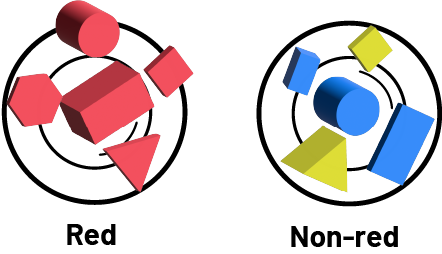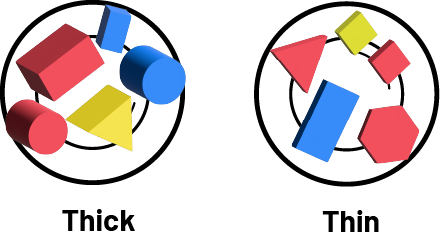D1.1 Sort sets of data about people or things according to one attribute, and describe rules used for sorting.
Activity 1: Sorting and Classifying
Ask students to:
- sort attribute blocks according to an attribute (for example, colour)

- classify the same attribute blocks according to a new attribute (for example, thickness).

Source: translated from Guide d’enseignement efficace des mathématiques, de la maternelle à la 3e année, Traitement des données et probabilité, p. 37.
Activity 2: Sort Shapes and Objects by Attribute
Materials
A variety of pattern blocks and three-dimensional objects
Directions
Provide students with pattern blocks and three-dimensional objects.
Ask students to sort the blocks and objects according to one attribute and explain their choice of attribute (sorting rule).
When sorting is complete, ask questions such as:
- What other attribute could you have used to sort the pattern blocks and the three-dimensional objects?
- Can you re-sort using a different attribute? Would the pattern blocks and three-dimensional objects be in the same categories?
- What are other situations where it is important to sort shapes and objects?
Possible Observation
Students can sort pattern blocks and three-dimensional objects, for example, into those that slide and those that do not, those that are two-dimensional and those that are not, those that are a certain colour and those that are not.
Activity 3: Classify Objects According to an Attribute
Materials
Variety of animals, either pictures or small toys
Directions
Provide students with different animals.
Ask students to classify the animals according to an attribute and explain their choice of attribute.
When sorting is complete, ask questions such as:
- What other attribute could you have used to classify the animals?
- Can you sort the animals using a different attribute? Would the animals be in the same categories?
- What are other situations where it is important to sort objects?
Possible Observation
For example, students can classify animals by their skin (scales, feathers, hair) or the way they move (flying, walking, or swimming).
